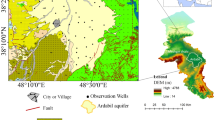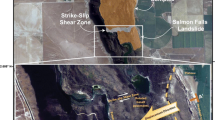Abstract
The Thompson River valley, south of Ashcroft in British Columbia, Canada, has experienced several landslides since the mid-1800s. The national railways that run along the valley cross a number of these landslides. All the landslides occur in glacial deposits, typically sliding on weak clay layers. Some have failed rapidly to very rapidly and are currently inactive or showing deformation rates from a few millimeters to centimeters per year. An evaluation of satellite InSAR (Interferometric Synthetic Aperture Radar) using RADARSAT-2 images between September 2013 and November 2015 provides new insight into landslide displacements in the Thompson River valley. This information enhances the ongoing hazard management of unstable terrain. This paper presents the comparison of the InSAR measurements with other instrumentation (GPS and ShapeAccelArrays™ -SAA) installed at one moving landslide and then addresses the extent and magnitude of the slope movements observed. InSAR was found to provide similar displacement values to those measured otherwise. The stable location showed displacements of +/−1 mm with an average near zero during the whole monitoring period. Six areas of slope movement were identified within the study area, all within or adjacent to the footprints of past landslides. The average line of sight (LOS) displacement rates range between 11 and 39 mm/year. Most of the landslides exhibited seasonal variations in velocity that corresponds to changes in river elevation in the valley.














Similar content being viewed by others
Abbreviations
- \( {\overline{U}}_{LOS} \) :
-
Unit vector in the direction of the line of sight
- \( {\overline{U}}_{slope} \) :
-
Unit vector in the downslope direction
- D LOS :
-
Displacement measured in the line of sight
- D slope :
-
Equivalent downslope displacements
- P C :
-
Percentage of movement captured by the line of sight
- AOI:
-
Area of Interest
- CN:
-
Canadian National Railway
- CP:
-
Canadian Pacific Railway
- CR:
-
Corner Reflector
- CSA:
-
Canadian Space Agency
- CT:
-
Coherent Target
- DInSAR:
-
Differential Interferometric Synthetic Aperture Radar
- ESA:
-
European Space Agency
- GPS:
-
Global Positioning System
- GSC:
-
Geological Survey of Canada
- IDW:
-
Inverse Distance Weighted
- InSAR:
-
Interferometric Synthetic Aperture Radar
- km:
-
kilometer
- LOS:
-
Line of Sight
- m:
-
meter
- mm:
-
millimeter
- NRCan:
-
Natural Resources Canada
- NSERC:
-
Natural Sciences and Engineering Research Council of Canada
- PSI:
-
Persistent Scatterer Interferometry
- S :
-
Scalar factor (secant of the angle between \( {\overline{U}}_{LOS} \) and \( {\overline{U}}_{slope} \))
- SAA:
-
ShapeAccelArrays™
- SAR:
-
Synthetic Aperture Radar
- SI:
-
Slope Inclinometer
- TC:
-
Transport Canada
References
Bianchini S, Cigna F, Del Ventisette C, Moretti S, Casagli N (2013) Monitoring landslide-induced displacements with TerraSAR-X persistent scatterer interferometry (PSI): Gimigliano case study in Calabria region (Italy). Int J Geosci 4(10):1467–1482
Canadian Space Agency (CSA) (2015) Satellite Characteristics Available from http://www.asc-csa.gc.ca/eng/satellites/radarsat/radarsat-tableau.asp. Accessed 16 Oct 2015
Cascini L, Fornaro G, Peduto D (2010) Advanced low- and full-resolution DInSAR map generation for slow-moving landslide analysis at different scales. Eng Geol 112:29–42
Cigna F, Bianchini S, Casagli N (2012) How to assess landslide activity and intensity with persistent scatterer interferometry (PSI): the PSI-based matrix approach. Landslides 10(3):267–283
Clague JJ, Evans SG (2003) Geologic framework of large historic landslides in Thompson River valley, British Columbia. J Environ Eng Geosci 9(3):201–212
Cloutier C, Locat J, Charbonneau F, Couture R (2015) Understanding the kinematic behavior of the active Gascons rockslide from in-situ and satellite monitoring data. Eng Geol 195:1–15
Colesanti C, Wasowski J (2006) Investigating landslides with space-borne synthetic aperture radar (SAR) interferometry. Eng Geol 88:173–199
Colesanti C, Ferretti A, Prati C, Rocca F (2003) Monitoring landslides and tectonic motions with the permanent scatterers technique. Eng Geol 68:3–14
Cruden DM, Varnes DJ (1996) Landslide types and processes. In: Turner AK, Schuster RL (eds) Landslides: investigation and mitigation. U.S. Transportation Research Board, Special Report, no 247: 36–75
Eshraghian A, Martin CD, Cruden DM (2007) Complex earth slides in the Thompson River valley, ash- croft, British Columbia. Environ Eng Geosci 13(2):161–181
Eshraghian A, Martin CD, Morgenstern NR (2008a) Hazard analysis of an active slide in the Thompson River valley, Ashcroft, British Columbia, Canada. Can Geotech J 45:297–313
Eshraghian A, Martin CD, Morgenstern NR (2008b) Movement triggers and mechanisms of two earth slides in the Thompson River valley, British Columbia, Canada. Can Geotech J 45:1189–1209
Ferretti A, Prati C, Rocca F (2001) Permanent scatters in SAR interferometry. IEEE Trans Geosci Remote Sens 39:8–20
Ferretti A, Monti-guarnieri A, Prati C, Rocca F, Massonnet D (2007) InSAR processing: a mathematical approach (part C). In: Fletcher K (ed) InSAR principles: guidelines for SAR interferometry processing and interpretation, p. ESA Publications, Noordwijk, pp 120–234
Frangioni S, Bianchini S, Moretti S (2015) Landslide inventory updating by means of persistent scatterer interferometry (PSI): the Setta basin (Italy) case study. Geomat Nat Haz Risk 6(5–7):419–438
Frodella W, Ciampalini A, Gigli G, Lombardi L, Raspini F, Nocentini M, Scardigli C, Casagli N (2016) Synergic use of satellite and ground based remote sensing methods for monitoring the San Leo rock cliff (northern Italy). Geomorphology 264:80–94
Froese CR, Keegan TR, Cavers DS, van der Kooij M (2005) Detection and monitoring of complex landslides along the Ashcroft rail corridor using spaceborne InSAR. In: Landslide Risk Management. Taylor & Francis Group, London, pp 565–570
Hendry MT, Macciotta R, Martin CD, Reich B (2015) Effect of Thompson River elevation on the velocity and instability of Ripley slide. Can Geotech J 52:257–267
Hungr O, Leroueil S, Picarelli L (2013) The Varnes classification of landslide types, an update. Landslides 11:167–194
Huntley DH, Bobrowsky P (2014) Surficial geology and monitoring of the Ripley slide, near Ashcroft, British Columbia, Canada; Geological Survey of Canada, Open File 7531, 21 p
Huntley DH, Bobrowsky PT, Qing Z, Xiaofei Z, Zhonghu Lv, Hendry M, Macciotta R, Schafer M, Le Meil G, Journault J, Tappenden K (2016) An Application of Optical Fibre Sensing Real-Time Monitoring Technologies at the Ripley Landslide, Near Ashcroft, British Columbia, Can Underwrit In: Proceedings of the 69th Canadian Geotechnical Conference, October 2–5, 2016, Vancouver, Canada
Kosar K, Revering K, Keegan TR, Black K, Stewart I (2003) The use of spaceborne InSAR to characterize ground movements along a rail corridor and open pit mine. In: Canadian conference on Geotechnique and natural hazards. June 8–10, Edmonton, Canada
Macciotta R, Hendry M, Martin CD, Elwood D, Lan H, Huntley D, Bobrowsky P, Sladen W, Bunce C, Choi E, Edwards T (2014) Monitoring of the Ripley Landslide in the Thompson River valley, B.C. In: Proceedings of Geohazards 6, June 15–18, 2014, Kingston, Canada
Macciotta R, Hendry M, Martin CD (2016) Developing an early warning system for a very slow landslide based on displacement monitoring. Nat Hazards 81:887–907
Mateos RM, Azañón JM, Roldán FJ, Notti D, Pérez-Peña V, Galve JP, Pérez-García JL, Colomo CM, Gómez-López JM, Montserrat O, Devantèry N, Lamas-Fernández F, Fernández-Chacón F (2017) The combined use of PSInSAR and UAV photogrammetry techniques for the analysis of the kinematics of a coastal landslide affecting an urban area (SE Spain). Landslides 14:743–754
Michoud C, Baumann V, Lauknes TR, Penna I, Derron M-H, Jaboyedoff M (2016) Large slope deformations detection and monitoring along shores of the Potrerillos dam reservoir, Argentina, based on a small-baseline InSAR approach. Landslides 13:451–465
Necsoiu M, McGinnis RN, Hooper DM (2014) New insights on the Salmon Falls Creek canyon landslide complex based on geomorphological analysis and multitemporal satellite InSAR techniques. Landslides 11:1141–1153
Newcomen W, Pritchard M (2009) CN ASH Sub Mile 55.2 / CPR THOM Sub Mile 52.80 South and Inner South Slide October 28, 2009 Monitoring event. BGC Engineering report
Novellino A, Cigna F, Sowter A, Ramondini M, Calcaterra D (2017) Exploitation of the intermittent SBAS (ISBAS) algorithm with COSMO-SkyMed data for landslide inventory mapping in north-western Sicily, Italy. Geomorphology 280:153–166
Porter MJ, Savigny KW, Keegan TR, Bunce CM, MacKay C (2002) Controls on stability of the Thompson River landslides. In: Proceedings of the 55th Canadian Geotechnical Conference, Niagara Falls, Canada
Roberts M, Danielson J, Schmid C (2015) CN ASH Sub Mile 55.2/CPR THOM Sub Mile 52.90 South and Inner South Slide April 7, 2015 Monitoring event. BGC Engineering report
Schafer M, Macciotta R, Hendry M, Martin CD, Bunce C, Choi E, Edwards T (2015) Instrumenting and monitoring a slow moving landslide. In: Proceedings of the 68th Canadian Geotechnical Conference, September 20–23, 2015, Quebec city, Canada
Schlögel R, Malet JP, Doubre C, Lebourg T (2016) Structural control on the kinematics of the deep-seated la Clapière landslide revealed by L-band InSAR observations. Landslides 13:1005–1018
Shi X, Liao M, Lu Z, Balz T (2016) Landslide stability evaluation using high-resolution satellite SAR data in the three gorges area. Q J Eng Geol Hydrogeol 49:203–211
Tappenden KM (2014) Climatic Influences on the Ashcroft Thompson River Landslides, British Columbia, Can Underwrit In: Proceedings of Geohazards 6, June 15–18, 2014, Kingston, Canada
Tappenden KM (2016) Impact of Climate Variability on Landslide Activity in the Thompson River Valley Near Ashcroft, B.C. In: Proceedings of the 69th Canadian Geotechnical Conference, October 2–5, 2016, Vancouver, Canada
Wasowski J, Bovenga F (2014) Investigating landslides and unstable slopes with satellite multi temporal interferometry: current issues and future perspectives. Eng Geol 174:103–138
Zhang Y, Meng X, Chen G, Qiao L, Zeng R, Chang J (2016) Detection of Geohazards in the Bailong River basin using synthetic aperture radar interferometry. Landslides 13:1273–1284
Acknowledgements
This research was made possible through the (Canadian) Railway Ground Hazard Research Program, which is funded by the Natural Sciences and Engineering Research Council of Canada (NSERC), Canadian Pacific Railway (CP), Canadian National Railway (CN) and Transport Canada (TC). The authors are grateful to the Geologic Survey of Canada (GSC), Natural Resources Canada (NRCan), and the Canadian Space Agency (CSA) for the satellite images and the resources for processing these images; and, Tom Edwards (CN) and Chris Bunce (BGC Engineering) for their insights about this area.
Author information
Authors and Affiliations
Corresponding author
Rights and permissions
About this article
Cite this article
Journault, J., Macciotta, R., Hendry, M.T. et al. Measuring displacements of the Thompson River valley landslides, south of Ashcroft, BC, Canada, using satellite InSAR. Landslides 15, 621–636 (2018). https://doi.org/10.1007/s10346-017-0900-1
Received:
Accepted:
Published:
Issue Date:
DOI: https://doi.org/10.1007/s10346-017-0900-1




